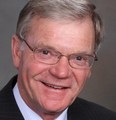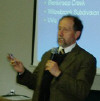2007 Beyond the Guidebook Seminar organized under the umbrella of the Water Sustainability Action Plan

“In BC, we have come to the realization that prescriptive approaches stifle innovation. By telling people how far they must go, that’s as far as they go. They don’t go much beyond what is required for an approval. The approach that we are taking is to set the goal. As a result, we are seeing people in local governments leapfrogging each other to see how close they can get to the goal,” stated Chris Jensen.










